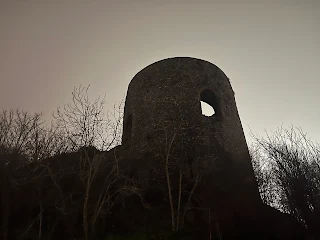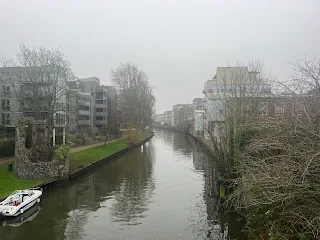Norwich, of course, can't be summarised in just twelve buildings - marketing should never get in the way of a city's history. So I'll discuss other aspects of Norwich that I saw in this post, ending with a Millwall match report, several weeks overdue.
Anglia House
Back when ITV's acronym-based name (Independent Television) made sense, and various parts of the UK had regional TV stations on Channel 3, Anglia dominated the East of England. They were initially centred here, at Anglia House, which is built on a slope, and its frontage is dominated by the serif lettering of ANGLIA TELEVISION. The building was previously the Agricultural Hall, which dates back to 1882, and was only converted into studio purposes in 1959, when Anglia were awarded their franchise.
Anglia did have another office, Studio E, during their heyday in the 1970s, but they've since sold it off, and thus Anglia House is all that remains, as the centre of ITV's eastern operations. Studio E was on Magdalen Street, the road leading off of Tombland as it crosses the River Wensum, and I didn't pay it a visit.
Norwich Bus Station
Like most bus stations in the UK, Norwich is a rather drab affair. On bleak Boxing Days like this one, it's likely all the more disheartening to see very few buses were running from the station, mainly longer services up to Peterborough or Great Yarmouth.

The bus station has been here since 1936, when the tram network in Norwich was replaced with various bus routes. It also had its own architectural quirk, with the largest unsupported roof span of any building in England. However, it has since been replaced, and in 2005 a new bus station opened. It won an award for Civic Building of the Year in 2006, though I'm not sure what they saw in it then.
River Wensum
Norwich consists of two rivers, the Yare and the Wensum, with the two meeting at a confluence in Whitlingham Country Park, on the city's eastern edge. It's the Wensum, however, that carves its way through the city centre, whilst the Yare takes the southern approach around Norwich. I didn't spend much time along the river, however, spending my time exclusively in the south, and as such I only encountered it when I visited...
Carrow Road
Norwich City played in two stadiums before they moved to Carrow Road, almost ninety years ago. The stadium was built on a sports ground (owned by local mustard manufacturers Colman's) in just a matter of weeks after the FA told the club their previous ground, The Nest, wasn't up to standard. Clearly Carrow Road has been adequate, considering it's been renovated multiple times, including the replacement of multiple stands, and doesn't seem to be going away anytime soon.
.HEIC)
The ground is hemmed in by the Wensum on one side, and major roads - one of them Carrow Road itself - on two others. The stand closest to the river, officially named for a security firm, is affectionately referred to as River End for this reason; however, that wasn't the stand I ended up staying at for the match.
The away end can be found at the South Stand, which actually refers to local politician Sir Arthur South and thus isn't a case of away stands being given dull names. Unlike at Bristol City, where the whole Atyeo Stand was reserved for away crowds, only a small section of the South Stand is devoted to away fans, though it's effectively closed off to the other fans.
I quite like Carrow Road, I think it's a decent stadium which is one of a dying breed of traditional cuboid-shaped stadiums; may it continue standing.
The match itself
Greeted by a mashup of various arena-certified electronic tracks (Fatboy Slim blending seamlessly into Kernkraft 400), the atmosphere sadly reached its peak before the match had even begun. Perhaps it being a cold, drab, dark Boxing Day meant people weren't as up to chanting, but the Millwall fans were all too quiet, and the Norwich fans weren't much better, either. Admittedly, the game was a battle of 10th against 13th, both sides slipping further away from the playoffs but not at threat of relegation - though that shouldn't be an excuse for the lack of chanting.
.HEIC)
Norwich scored first from a counter-attacking scramble, and scored second with another counter-attacking scramble. Aside from that, they didn't create much; neither did Millwall. Each time Norwich scored, we were treated to their caustic goal music (an unfamiliar premise down in southeastern London) and the rare eruption of fan joy at the other stands.
Come the second half, and Millwall were continuously making chances, though they were often ineffective. They were much better organised, and the away crowd were finally finding their voices. When Romain Esse scored from a long range shot to cut the gap to 2-1, we were all jubilant, mainly because there was finally a goal without the goal music.
After this, nothing notable happened, and Millwall ended up losing timidly. Norwich rose above them in the table, and suddenly the home crowd were on their feet as more dance music was played at the end. For the first time in my life, I had witnessed my team lose an away match (this was my third time for Millwall).
The nice thing is that, with time having passed since, I can evaluate how Millwall and Norwich have fared since. Norwich are now six points ahead, the playoffs now more realistic for them than ever. I wonder how they will compare after the rematch in April.
The Devil's Tower
As I was walking away from the stadium, disappointed by the result, I spotted this ghostly brick remnant from afar.

The Devil's Tower was likely a military fortification built along the Wensum, though no records seemingly indicate it having been occupied, though wardens have been assigned to the tower. It was constructed sometime in the 1330s to control access to Norwich by water through the city walls, with it being one of two "boom towers" - the other, Cow Tower, built further up the river - to play this role. Nowadays, it peers unnervingly over the city, all alone, instead.


Breh
ReplyDeleteThat is truly fascinating!
ReplyDeleteAbsolutely spectacular!
ReplyDeleteWow!
ReplyDelete